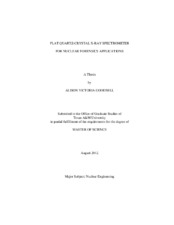| dc.contributor.advisor | Charlton, William S. | |
| dc.creator | Goodsell, Alison | |
| dc.date.accessioned | 2012-10-19T15:30:25Z | |
| dc.date.accessioned | 2012-10-22T18:04:02Z | |
| dc.date.available | 2014-11-03T19:49:14Z | |
| dc.date.created | 2012-08 | |
| dc.date.issued | 2012-10-19 | |
| dc.date.submitted | August 2012 | |
| dc.identifier.uri | https://hdl.handle.net/1969.1/ETD-TAMU-2012-08-11627 | |
| dc.description.abstract | The ability to quickly and accurately quantify the plutonium (Pu) content in pressurized water reactor (PWR) spent nuclear fuel (SNF) is critical for nuclear forensics purposes. One non-destructive assay (NDA) technique being investigated to detect bulk Pu in SNF is measuring the self-induced x-ray fluorescence (XRF). Previous XRF measurements of Three Mile Island (TMI) PWR SNF taken in July 2008 and January 2009 at Oak Ridge National Laboratory (ORNL) successfully illustrated the ability to detect the 103.7 keV x ray from Pu using a planar high-purity germanium (HPGe) detector. This allows for a direct measurement of Pu in SNF. Additional gamma ray and XRF measurements were performed on TMI SNF at ORNL in October 2011 to measure the signal-to-noise ratio for the 103.7 keV peak.
Previous work had shown that the Pu/U peak ratio was directly proportional to the Pu/U content and increased linearly with burnup. However, the underlying Compton background significantly reduced the signal-to-noise ratio for the x-ray peaks of interest thereby requiring a prolonged count time. Comprehensive SNF simulations by Stafford et al showed the contributions to the Compton continuum were due to high-energy gamma rays scattering in the fuel, shipping tube, cladding, collimator and detector1. The background radiation was primarily due to the incoherent scattering of the 137Cs 661.7 keV gamma. In this work methods to reduce the Compton background and thereby increase the signal-to-noise ratio were investigated.
To reduce the debilitating effects of the Compton background, a crystal x-ray spectrometer system was designed. This wavelength-dispersive spectroscopy technique isolated the Pu and U x rays according to Bragg's law by x-ray diffraction through a crystal structure. The higher energy background radiation was blocked from reaching the detector using a customized collimator and shielding system.
A flat quartz-crystal x-ray spectrometer system was designed specifically to fit the constraints and requirements of detecting XRF from SNF. Simulations were performed to design and optimize the collimator design and to quantify the improved signal-to-noise ratio of the Pu and U x-ray peaks. The proposed crystal spectrometer system successfully diffracted the photon energies of interest while blocking the high-energy radiation from reaching the detector and contributing to background counts. The spectrometer system provided a higher signal-to-noise ratio and lower percent error for the XRF peaks of interest from Pu and U. Using the flat quartz-crystal x-ray spectrometer and customized collimation system, the Monte Carlo N-Particle (MCNP) simulations showed the 103.7 keV Pu x-ray peak signal-to-noise ratio improved by a factor of 13 and decreased the percent error by a factor of 3.3. | en |
| dc.format.mimetype | application/pdf | |
| dc.language.iso | en_US | |
| dc.subject | x-ray fluorescence | en |
| dc.subject | Pu | en |
| dc.subject | U | en |
| dc.subject | nuclear forensics | en |
| dc.subject | spent nuclear fuel | en |
| dc.subject | crystal x-ray spectrometer | en |
| dc.title | Flat Quartz-Crystal X-ray Spectrometer for Nuclear Forensics Applications | en |
| dc.type | Thesis | en |
| thesis.degree.department | Nuclear Engineering | en |
| thesis.degree.discipline | Nuclear Engineering | en |
| thesis.degree.grantor | Texas A&M University | en |
| thesis.degree.name | Master of Science | en |
| thesis.degree.level | Masters | en |
| dc.contributor.committeeMember | Poston, John W. | |
| dc.contributor.committeeMember | Vedlitz, Arnold | |
| dc.type.genre | thesis | en |
| dc.type.material | text | en |
| local.embargo.terms | 2014-10-22 | |


